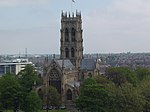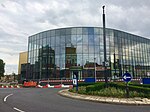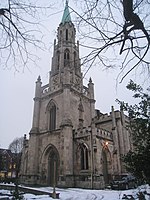Doncaster Civic Office
Buildings and structures in DoncasterCity and town halls in South YorkshireGovernment buildings completed in 2012Use British English from April 2022

Doncaster Civic Office is a municipal building in Waterdale, Doncaster, South Yorkshire, England. The structure is the meeting place of Doncaster Metropolitan Borough Council.
Excerpt from the Wikipedia article Doncaster Civic Office (License: CC BY-SA 3.0, Authors, Images).Doncaster Civic Office
Doncaster Hyde Park
Geographical coordinates (GPS) Address Nearby Places Show on map
Geographical coordinates (GPS)
| Latitude | Longitude |
|---|---|
| N 53.5205 ° | E -1.1304 ° |
Address
DN1 3EY Doncaster, Hyde Park
England, United Kingdom
Open on Google Maps








